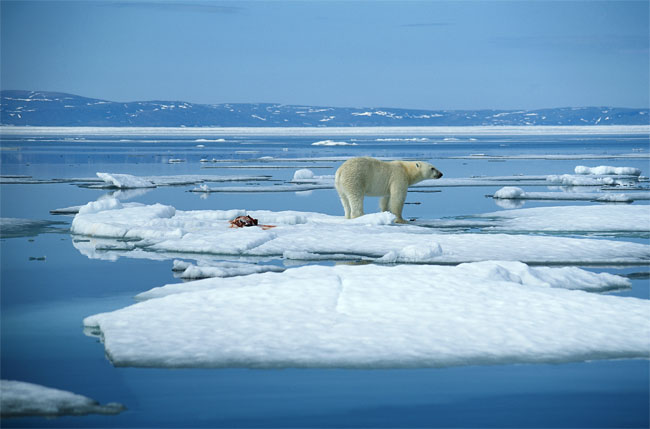Polar Bears Forced to Land and Water

As Arctic sea ice melts, polar bears are changing their habitat, shifting from their preferred ice hunting grounds to land and open water, according to a new long-term study.
The findings have implications for people as well as polar bears, since the shift makes it more likely that humans will encounter these large animals on land, the researchers say.
The study was conducted over a 27-year period, from 1979 to 2005. Polar bears were observed in and around the southern Beaufort Sea during the fall as part of an annual aerial survey to collect information on bowhead whale migration routes. The Beaufort Sea is part of the Arctic Ocean with shores on Alaska as well as Canada's Yukon, Northwest Territories and Arctic Islands.
Data showed that as ice conditions changed, bears were being found in different habitats. Between 1979 and 1987, 12 percent of bear sightings were on land or in open water, but not on ice. That number increased to 90 percent between 1997 and 2005.
In addition, the number of bears sighted steadily increased from 138 bears between 1979 and 1987, to 271 bears between 1988 and 1996, and finally to 468 bears between 1997 and 2005.
That doesn't mean polar bear numbers are on the rise in total or in nearshore areas. Karyn Rode, a polar bear biologist with the U.S. Fish and Wildlife Service in Anchorage, Alaska, warns that this study was not designed to estimate the number of bears using the nearshore area, and so it should not be concluded that more bears are occurring in the nearshore waters off the Southern Beaufort Sea coast.
However, Rode said, "Our results do suggest that bears that use the nearshore area are more likely to occur on land in recent years because their preferred habitat, sea ice, is unavailable."
Sign up for the Live Science daily newsletter now
Get the world’s most fascinating discoveries delivered straight to your inbox.
In the Beaufort Sea region, there was less ice in 2005 than when the study period began in 1979. In general, freeze-up is later and spring melt comes earlier with measurements showing since 1979 the summer melt period has increased by 13 days per decade. This is one reason for the region's rapid retreat of multi-year ice, which provides a thicker, more stable platform for the bears to hunt and den.
Last year, international researchers involved in a separate study looking at melting Arctic ice and the effects on ecosystems concluded: "The Arctic as we know it may be a thing of the past."
The new study is helpful in highlighting the need to proactively develop programs to manage bear-human interactions in coastal areas, researchers said. Bear-human interactions in Native villages and with industry in Alaska have been on the rise in recent years.
The paper was published in the December issue of the journal Arctic.
- Top 10 Species You Can Kiss Goodbye
- Image Gallery: Endangered and Threatened Wildlife
- Arctic Sea Ice Shrinks to Second Lowest on Record











